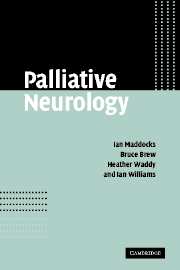Book contents
- Frontmatter
- Contents
- Foreword
- Note on drugs and abbreviations
- Section I Palliative Management
- Section II Major discomforts in advanced neurological illness
- Section III Major neurological conditions requiring palliation
- Section IV Ethical issues
- 1 Consent and decision-making
- 2 Advance directives
- 3 Proxy decision-making
- 4 Ethical issues in states of disordered consciousness
- 5 Terminal sedation
- 6 Euthanasia
- Section V Appendices
- Index
5 - Terminal sedation
from Section IV - Ethical issues
Published online by Cambridge University Press: 08 January 2010
- Frontmatter
- Contents
- Foreword
- Note on drugs and abbreviations
- Section I Palliative Management
- Section II Major discomforts in advanced neurological illness
- Section III Major neurological conditions requiring palliation
- Section IV Ethical issues
- 1 Consent and decision-making
- 2 Advance directives
- 3 Proxy decision-making
- 4 Ethical issues in states of disordered consciousness
- 5 Terminal sedation
- 6 Euthanasia
- Section V Appendices
- Index
Summary
There is little doubt that the provision of continuous analgesia and sedation to reduce discomfort in the terminal phase of any illness can hasten death, if only by a matter of hours, though usually not in any rapid or predictable timescale.
Families who have stayed patiently by the side of a slowly deteriorating patient with a terminal illness commonly welcome the release and the relief that follows the final onset of death. But they can easily worry that by assenting to an offer of sedation, they have been complicit in a form of euthanasia.
They will need time to ask questions and hear staff responses. It will be suggested that there is no intention to kill in providing this therapy; the aim is to ensure that dying (which is happening anyway) is free from any distress of pain, restlessness or delirium. What is being provided is a continuing appropriate treatment for the patient, not some new and different intervention carrying a potentially illegal and fatal consequence.
Some families will ask that sedation and analgesia be withheld. They may hold a hope that the patient has some communication to make in the dying moments (an expectation possibly fostered by the depiction of death on television) or they may have religious objections to sedation at this time. Some Buddhist traditions, for example, hope for full lucidity and awareness at the moment of death as an important component of satisfactory reincarnation.
- Type
- Chapter
- Information
- Palliative Neurology , pp. 218Publisher: Cambridge University PressPrint publication year: 2005



